11.4. People¶
Administration menu → People
In the People menu of the administration site administrators can:
search for people
change settings for individual people
suspend and delete accounts
make people site staff or administrators
die Einstellungen zu Benachrichtigungen prüfen
add and update accounts manually or by CSV
Berichte aufrufen
In the People menu of the administration institution administrators can:
search for people
change settings for individual people
suspend and delete accounts
die Einstellungen zu Benachrichtigungen für ihre Institutionsadministratoren prüfen
add and update accounts manually or by CSV
Berichte aufrufen
11.4.1. People search¶
Administration menu → People → People search
Bemerkung
Site administrators can search for anybody on the entire site while institution administrators can only search among the members of their institution(s).
11.4.1.1. Standard people search¶
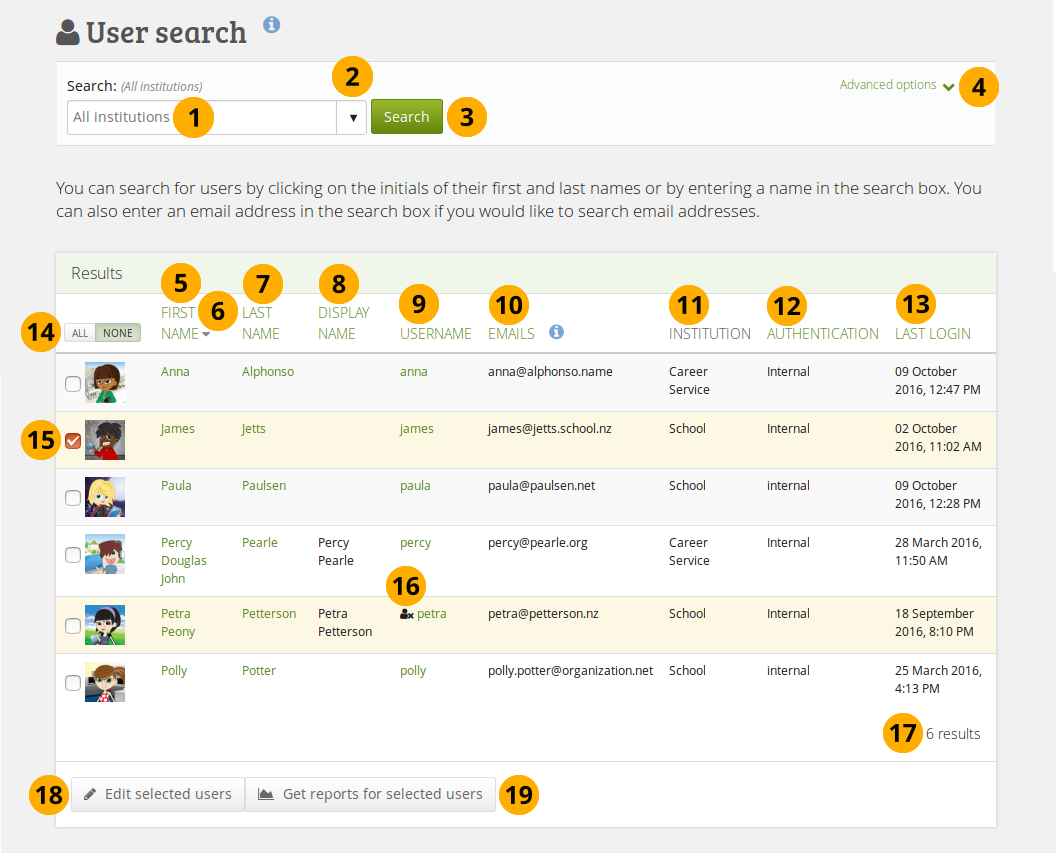
People search¶
Search: Enter your search term. The default text in the field shows you in which institution context you perform your search. Type the name, display name, username or email address or any partial thereof you wish to search for in the search field. If you turned on the exact search, you need to provide the correct name or email address and not a partial one.
Bemerkung
Both primary and secondary email addresses are searchable.
Use the drop-down arrow to choose a single institution in which to search for a person.
Click the Search button to start your search.
Click the ‚Advanced options‘ link to make filtering options visible.
First name: The first name links through to the person’s profile page.
Click the arrow to change the sort order of the column. All columns but the institution one are sortable.
Last name: The last name links through to the person’s profile page.
Display name: The display name is shown.
Username: This is the internal Mahara username. Click the username to go to this person’s account settings page.
Emails: The primary email address as well as all secondary email addresses are displayed.
Bemerkung
Secondary email addresses are displayed in parentheses.
Institution: The institution or institutions that a person belongs to are displayed.
Authentication: The authentication method for this account is shown.
Last login: The date and time of the last login is visible.
Click the All button to select all accounts and click the None button to deselect all accounts.
You can also tick the checkbox for an individual to select them.
Accounts that are suspended or expired have the Inactive account icon next to their username.
The number of search results are available. If there are more than ten accounts in the search results, you have a pager available to go to more results.
Click the Edit selected accounts button to perform the bulk actions to
suspend people
delete accounts
change the authentication method of accounts
Click the Get reports for selected accounts button to
view account reports
download account information for further actions
11.4.1.2. Advanced search options¶
Sie können jede Suche kombinieren und Filter-Optionen verwenden. Wenn Sie zu viele Kriterien verwenden, kann es sein, dass Sie kein Ergebnis erzielen.

Advanced search options¶
Search: You see the institution context in which your search is performed.
Use the drop-down arrow to choose a single institution in which to search for your a person.
Click the Search button to filter results for this institution only.
Click the ‚Advanced options‘ link to make additional filtering options visible.
First name: Filter the people you wish to display by the initial of their first name. Click the letter of the alphabet to narrow your search.
Last name: Filter the people you wish to display by the initial of their last name. Click the letter of the alphabet to narrow your search.
Last login: You have several options:
Anybody: Display anybody who fits any other search / filter criteria.
People have logged in: Display everybody who has logged in at least once.
People have never logged in: Display everybody who has never logged in.
People have logged in since: Display everybody who has logged in since a specified date and time.
People have not logged in since: Display everybody who has not logged in since a specified date and time.
Choose a date and time for the login filter by either typing it in or selecting it via the calendar that pops up when you click into the field.
Duplicate email addresses: Tick this checkbox if you only want to display people whose email address is in the system twice so you can deal with them more easily.
Bemerkung
Normally, duplicate email addresses are not possible, but if a person imports a Leap2A file or if an external authentication method is used, duplicates can happen.
11.4.1.3. Account bulk actions¶
You can perform a number of bulk actions for accounts on the Bulk actions page:
Suspend them.
Change their authentication method.
Set spam probation points.
Delete them.
11.4.1.3.1. Suspend accounts¶
You can suspend accounts in bulk disallowing them to log into their accounts. Their portfolios will not be available anymore to others.
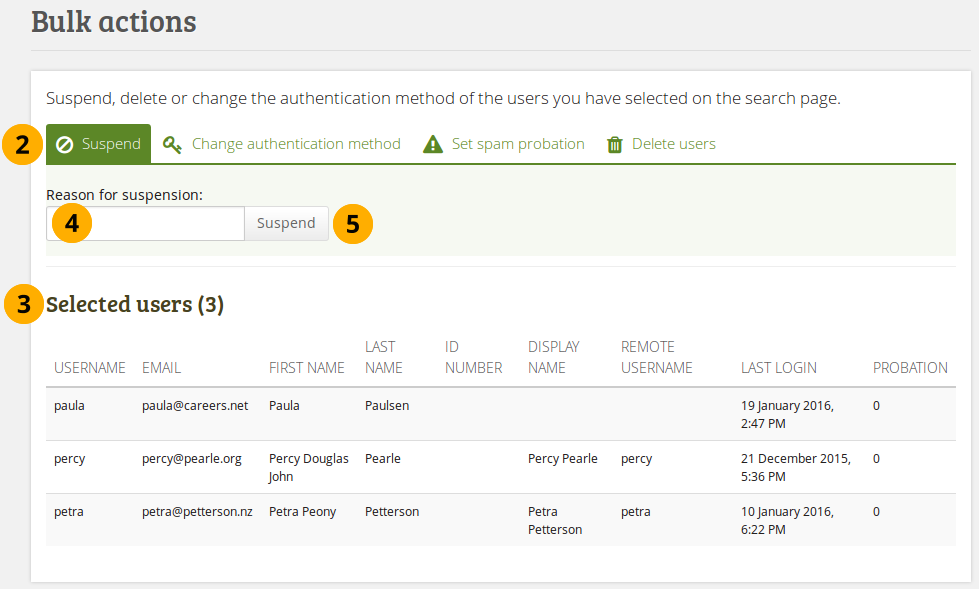
Account bulk actions: Suspend accounts¶
On the People search page, select the accounts that you wish to suspend and click the Edit button.
Make sure that you are on the Suspend tab.
Selected accounts: Review the accounts you have selected.
Reason for suspension: Provide a reason for suspending the accounts listed on this page.
Click the Suspend button to prevent these account holders from accessing their accounts.
Bemerkung
If you made a mistake or want to remove a temporary suspension, you can do so under Suspended and expired accounts.
11.4.1.3.2. Change authentication method¶
You can change the authentication method for many accounts at once.
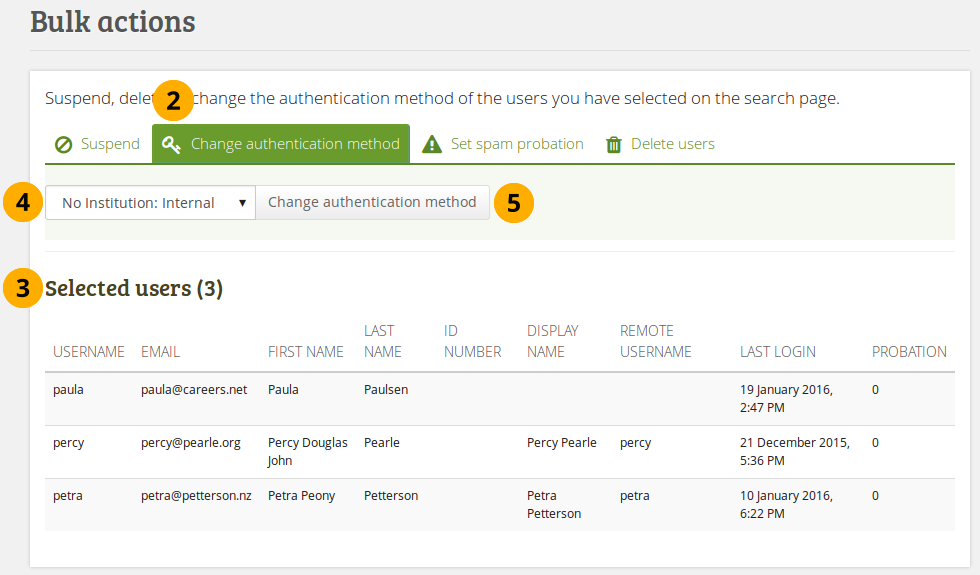
Account bulk actions: Change authentication method¶
On the People search page, select the accounts for whom you wish to change the authentication method and click the Edit button.
Make sure that you are on the Change authentication method tab.
Selected accounts: Review the accounts you have selected.
Select the new authentication method from the drop-down menu. That includes choosing the correct institution and associated authentication method.
Click the Change authentication method button to make the change.
Bemerkung
You need to change or add a remote username for some authentication methods. You will need to do that in a separate step. For information on that, please see the instructions for changing the authentication method and remote username.
11.4.1.3.3. Set spam probation¶
You can change the spam probation points for many account holders at once.
Bemerkung
This feature is only available on sites that have spam probation turned on.
Newly self-registered persons - no matter whether the institution requires explicit administrator confirmation or not - start out with a certain number of ‚probation points‘ on their account. While they have any probation points, they are considered a probationary person and cannot create public pages in their portfolio or post links or images to potentially public content such as comments, wall posts or forum posts.
Each time a probationary person makes a post in a forum, and the post is replied to by a non-probationary person, the probationary person loses one probation point. When the number of points reaches zero, they are no longer on probation.
Probation points have no effect on persons who have staff or administrator status.
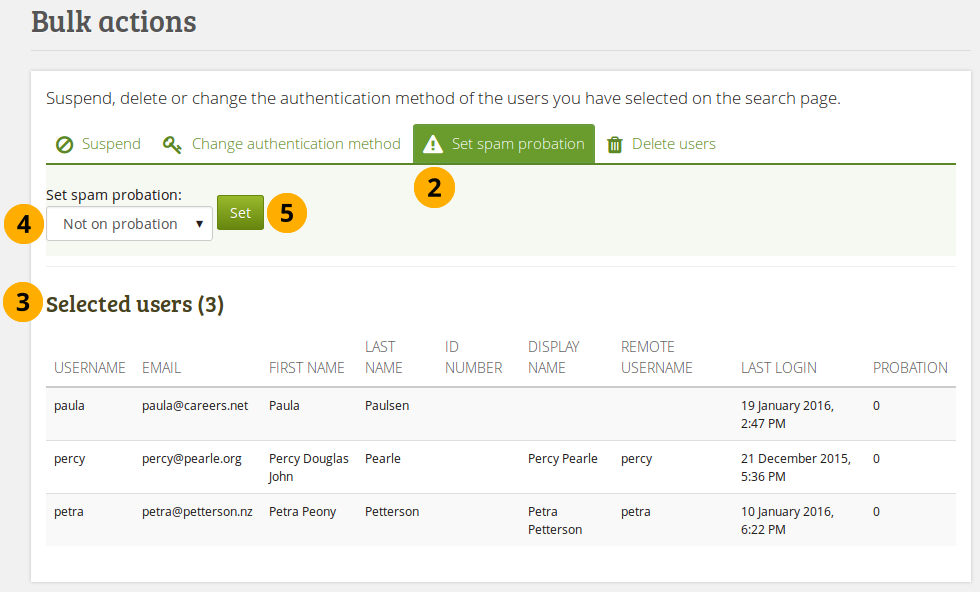
Account bulk actions: Set spam probation¶
On the People search page, select the accounts for whom you wish to set probation points and click the Edit button.
Make sure that you are on the Set spam probation tab.
Selected accounts: Review the accounts you have selected.
Select the number of probation points from the drop-down menu that you wish to give the selected accounts.
Click the Set button to make the change.
11.4.1.3.4. Delete accounts¶
You can delete many accounts at once.
Warnung
When you delete an account, all personal data is wiped from the system. This action cannot be undone. The person’s contributions in groups, e.g. forum messages, uploaded files and pages created in a group, are still available, but are made anonymous by changing the name to ‚Deleted account‘ as author where an author is shown.
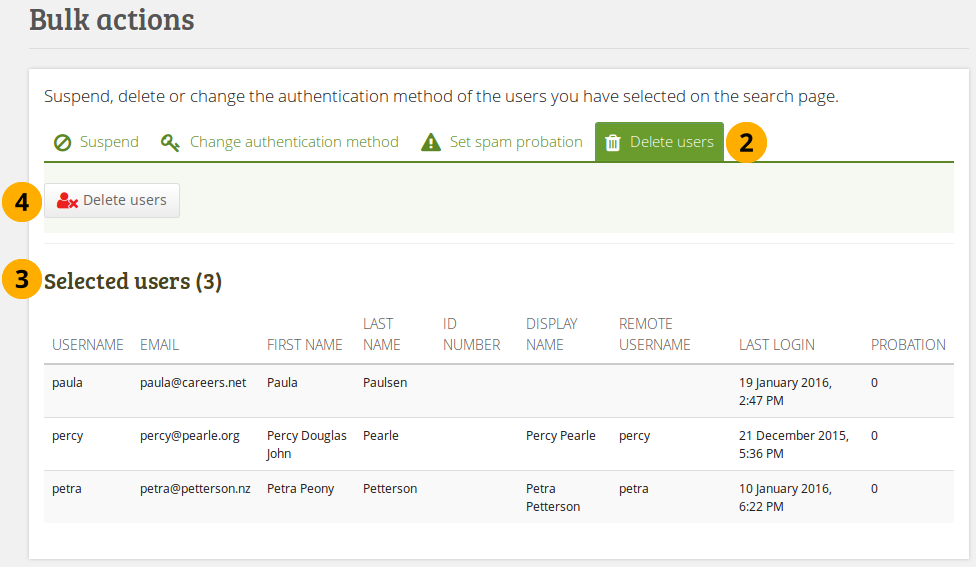
Account bulk actions: Delete accounts¶
On the People search page, select the accounts that you wish to delete and click the Edit button.
Make sure that you are on the Delete accounts tab.
Selected accounts: Review the accounts you have selected.
Click the Delete button. The accounts will be deleted along with their data.
Bemerkung
Forum posts and comments that people have written or portfolio pages in which they were involved in groups are not deleted. However, their name is being removed.
11.4.2. Accounteinstellungen¶
Administration menu → People → People search → Click on a username
On the Account settings page of a person in the administration area, you can perform a number of actions to manage the account. However, you cannot change personal information about this person, e.g. name or email, from this page. This can only be done in the Profile area of the account or via the Add people by CSV page.

Overview of the account settings page¶
11.4.2.1. Einloggen als¶
As administrator you have the power to log in as any person that you manage and masquerade as them.
Bemerkung
Site administrator can log in as anybody while institution administrators can only perform this action for members of their institution(s).
It is a great function for troubleshooting an account because you see everything as the person would without having to know the password.
Warnung
This function can be misused by administrators because you can make changes to the person’s portfolio and artefacts as well as participate in groups while logged in as them. People should be aware of this function and that an administrator can enter their account.
Sites should have clear policies around the use of this function so that the privacy of people and their portfolios and collaborative work is protected. Therefore, there should also not be many people within an institution who have administrator rights.
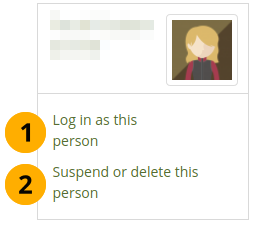
Log in as another person¶
Click on the person’s name to go to their profile page. You can then click the Log in as … link to become that person from that screen.
Click the Log in as link to become that person. You see a warning bar at the top of the browser window telling you that you are masquerading as that person.

Stop masquerading as another person¶
Wenn Sie wieder zu Ihrem eigenen Account zurückkehren wollen, klicken Sie auf den Wieder [Ihr Name] werden-Link oben auf der Seite.
When the site administrator enabled the logging of all or just masquerading events, administrators may be required to provide a reason for the masquerading and a notification about this may be sent to the account holder.
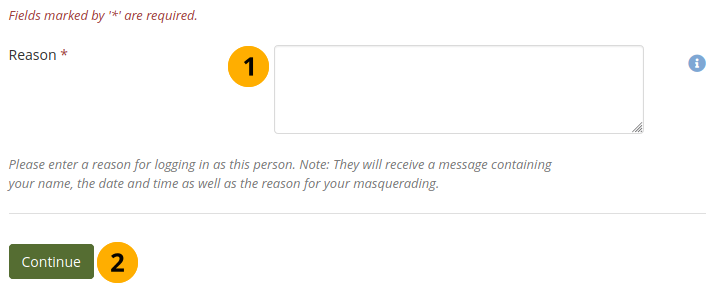
Provide a reason for masquerading as another person¶
Write why you are masquerading as this person. This reason may be sent to the person if the site administrator demands that.
Click the Continue button to log in as that person.
If the site administrator decided to have account holders notified of the masquerading, you would see the screen notice ‚The person has been notified of this masquerading session.‘
When the site administrator decided to send notifications to people when an administrator logs into their account, the peoples receive this notification in their inbox. Depending on their notification settings, it can also be delivered via email.

Notification a person receives when an administrator masquerades¶
Aktivitätentyp: Die Login-als-Benachrichtigung ist eine Systemnachricht. Wenn Sie eine große Zahl von Benachrichtigungen erhalten, können Sie diese filtern.
Click the bar to see the full text of the message.
The system message ‚An administrator logged in as you‘ contains the name of the administrator and the time when the administrator started masquerading. If the site administrator requires a reason to be sent for the masquerading, it is displayed as well.
The name of the administrator who logged in as you is linked to the profile page for you to find out more about them or send them a message.
11.4.2.2. Suspend a person¶
Suspend a person if they do not follow the terms and conditions of the site and behave inappropriately. Suspended people cannot log in, but all their content is still available.

Suspend a person¶
Click the link Suspend or delete this person. A pop-up windows becomes visible.
Reason: Provide a reason for your suspension. This is particularly useful when you are not the only administrator and / or need to remember after some time why you suspended this person.
Click the Suspend person button to disallow them from logging in.
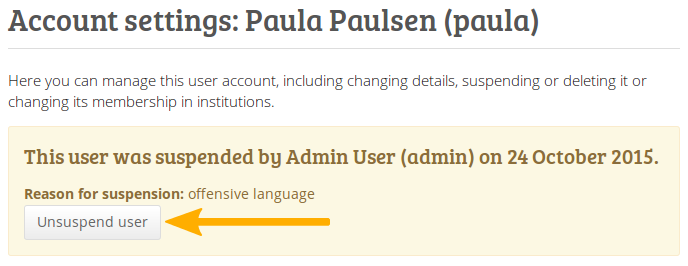
Suspension notice on the person’s account settings page¶
When a person has been suspended, the suspension message appears on their account settings page stating the reason and the date for the suspension and giving the administrators the possibility to unsuspend the person by clicking the Unsuspend person button.
You can unsuspend a person from this page or together with others on the Bulk actions page.

Suspended person tries to log in and gets suspension message¶
When the person tries to log in, they will see the suspension message and the reason. They can then contact an administrator via the ‚Contact us‘ form for further action.
11.4.2.3. Delete account¶
Peoples can delete their own accounts in their account settings if self-registration is allowed by their institution. Administrators can also delete accounts at any time.
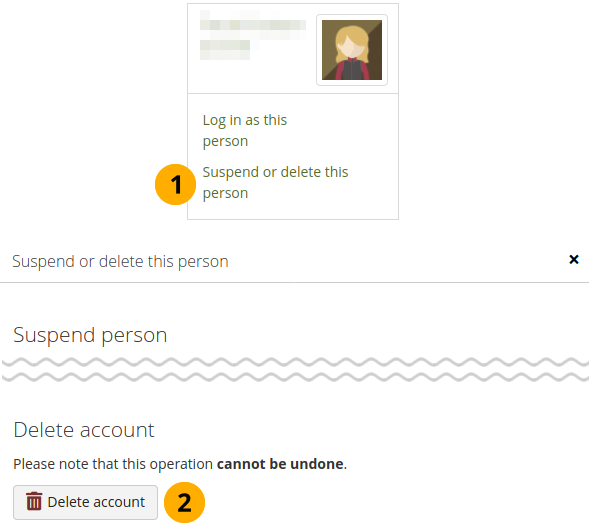
Delete an account¶
Click the link Suspend or delete this person. A pop-up windows becomes visible.
Click the Delete account button to delete this account permanently. This action cannot be undone. As this is a permanent action, you see a confirmation pop-up window that you will have to acknowledge.
Warnung
When you delete an account, all personal data is wiped from the system. This action cannot be undone. The person’s contributions in groups, e.g. forum messages, uploaded files and pages created in a group, are still available, but are made anonymous by changing the name to ‚Deleted account‘ as author where an author is shown.
Bemerkung
If an account was deleted by accident - either by a person themselves or by an administrator - swift action may result in recovery of (most of) the data from a backup file. This requires access to the server’s backups and the backend of Mahara. More information is available on the wiki under Restoring a deleted account.
11.4.2.4. System-Accounteinstellungen ändern¶
You can view and change a number of settings for an account.
Bemerkung
Depending on the authentication method that is associated with this account, you may not be able to edit all settings.
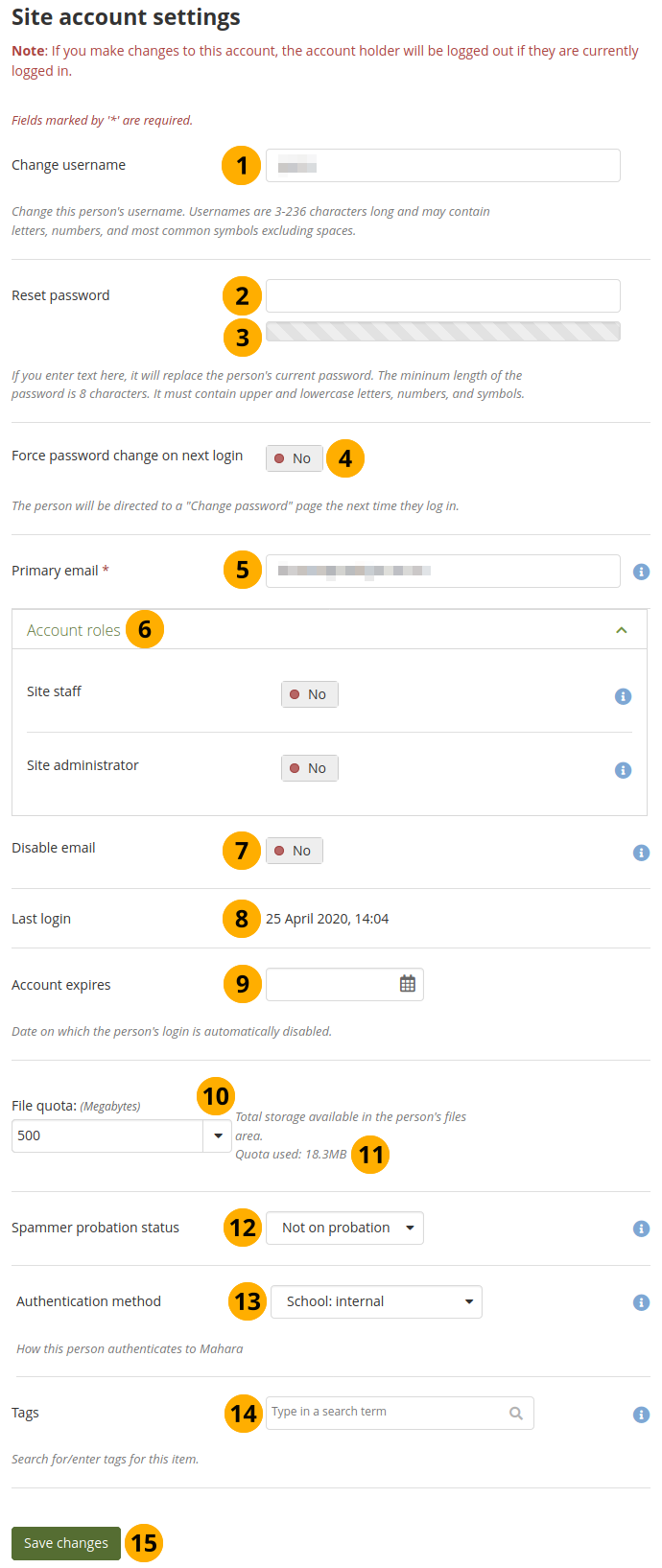
Site account settings of a person¶
Change username: Give the person a different username. This field is not available when the account is managed by an external authentication method.
Reset password: Change the password for this account. This field is not available when the account is managed by an external authentication method.
The password strength indicator gives you an idea of how strong your password is in relation to the password policy.
Force password change on next login: Change the switch to ‚Yes‘ if the person shall change the password upon the next login. This option is not available when the account is managed by an external authentication method.
Primary email: Displayed is the primary email address for this person. This email address is used for any notifications. You can change that email address here.
Bemerkung
The previously used email address stays in the account as secondary email address until the person deletes it.
 Account roles: While account roles have existed in Mahara for a long time, it is now possible to extend them a bit more easily. All account roles a person has can be displayed here either for the site or further down in the individual institution(s) in which the person is a member. The default built-in roles are:
Account roles: While account roles have existed in Mahara for a long time, it is now possible to extend them a bit more easily. All account roles a person has can be displayed here either for the site or further down in the individual institution(s) in which the person is a member. The default built-in roles are:Site staff: Change the switch to ‚Yes‘ if the person shall become a staff member for the entire site.
Site administrator: Change the switch to ‚Yes‘ if the person shall have full administrative rights for the entire site.
Siehe auch
 New account roles can be set via SAML for SSO accounts.
New account roles can be set via SAML for SSO accounts.Disable email: Change the switch to ‚Yes‘ to disable the sending of emails for this account. If email is disabled, notifications and messages can only be viewed in the internal inbox. You can set up your Mahara site so that emails are disabled automatically if they are bounced back.
Warnung
When the email address is disabled, account holders cannot reset their passwords themselves as no email can be sent.
Last login: The date and time when the person logged into Mahara for the last time is displayed.
Account expires: Enter a date via the calendar if you want to set an expiry date.
Bemerkung
The default setting is that the date is not specified. You can set an automatic account expiry date for everyone in the account settings of the site configuration.
File quota: Change the storage allowance for a person’s personal files area. Institution administrators may not be able to update the quota if the site administrator disallowed that. The default value as set in the files configuration in the plugin administration.
Quota used: You can see how much this person has already used of their allocated quota.
Spammer probation status: This setting controls whether the person is considered to be on probation as a possible spammer. See the spam probation levels for more information.
Bemerkung
This feature is only available on sites that have spam probation turned on.
Authentication method: Choose the authentication method for this person. A site administrator can set up the authentication methods in the institution administration. Depending on the authentication method that you have chosen, you may have to provide a remote username to allow the person to log in.
Bemerkung
You only see the authentication methods that you are allowed to assign to the person based on their institution membership.
Das Feld Nutzername für externe Authentifizierung ist nur verfügbar wenn die gewählte Authentifizierungsmethode einen entfernten Nutzernamen erfordert. Damit ist für den Administrator sichtbar, ob ein externer Nutzername bereitgestellt wurde oder nicht.
Tags: A person can be tagged by an administrator. The tag of the institution to which the person belonged prior to joining a new institution is not displayed to avoid its deletion.
Klicken Sie auf den Änderungen speichern-Button, wenn alle Änderungen vorgenommen sind.
11.4.2.5. Institutionseinstellungen ändern¶
You can view and change settings regarding a person’s membership in institutions. Depending on the site settings for institutions, a person may be added to more than one institution.
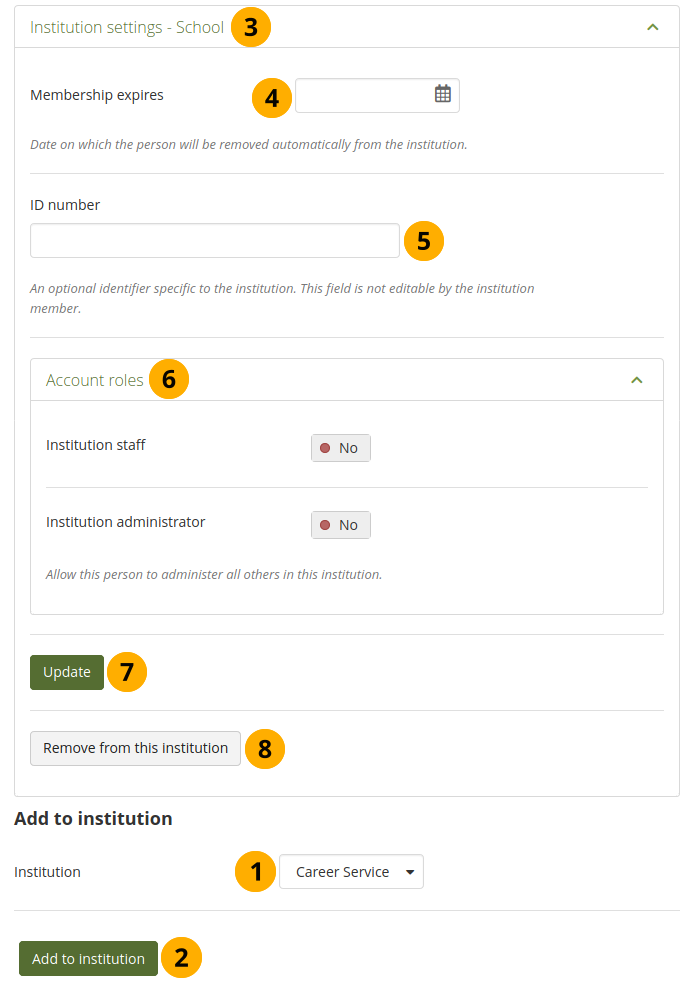
Institution settings for a person¶
Institution: Choose the institution to which you want to add this person from the drop-down menu.
Bemerkung
Only site administrators or institution administrators who have administrator permissions in more than one institution see this option.
Click the Add to institution button to make this person a member of this institution.
Click the Institution settings bar to see more details about the person in this institution. The bar shows the name of the institution.
Membership expires: Click into the field to view the date picker and choose when you want to remove this person from this institution. They are removed from your institution on that date, but retain their account and can still log in.
Bemerkung
The default setting is that the date is not specified. You can set an automatic institution membership expiry date for all members in your institution in the settings for your institution.
ID number: Provide an optional identifier for this person in this institution. This field is not editable by the institution member.
 Account roles: While account roles have existed in Mahara for a long time, it is now possible to extend them a bit more easily. All account roles a person has in an institution can be set here. The default built-in roles are:
Account roles: While account roles have existed in Mahara for a long time, it is now possible to extend them a bit more easily. All account roles a person has in an institution can be set here. The default built-in roles are:Institution staff: Change the switch to ‚Yes‘ if you want to give this member staff rights in this institution. This will allow the them to create controlled groups for example.
Institution administrator: Change the switch to ‚Yes‘ if you want to make this member an administrator of this institution.
Klicken Sie auf den Aktualisieren-Button, um die Änderungen zu speichern.
Click the Remove from this institution button to disassociate this person from this institution. The account will not be deleted. The person will only not be associated with this institution anymore.
11.4.3. Suspended and expired accounts¶
Administration menu → People → Suspended and expired accounts
A list of all suspended and expired accounts is available in the sub-menu Suspended and expired accounts. Here you can unsuspend / reactivate or delete them.
Bemerkung
Site administrators see all people whereas institution administrators only see people who are members of their institution(s).
11.4.3.1. Suspended accounts¶
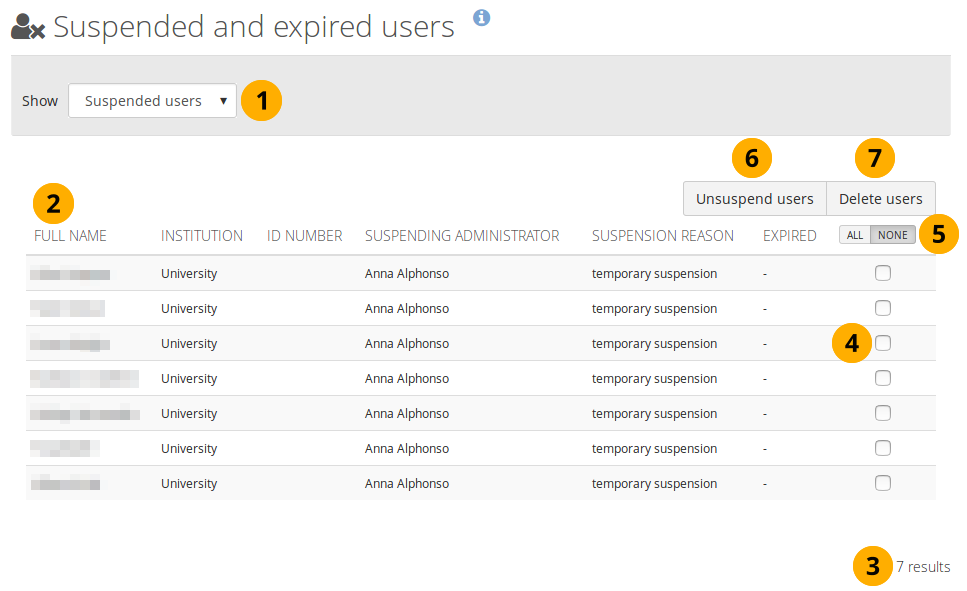
List of all suspended accounts¶
Show: Select to view suspended accounts.
Basic details about each account are displayed to ensure that you are looking at the correct ones. That includes displaying the suspension reason.
The total number of suspended accounts is shown.
Select the account(s) for which you want to perform the same action.
Click the All button if you want to select all suspended accounts or click the None button to reset your selection.
Click the Unsuspend people button to reinstate the accounts for all selected accounts.
Click the Delete accounts button to delete all selected accounts in bulk. This action cannot be undone and all personal information of these people will be deleted (see delete accounts).
Warnung
When you delete an account, all personal data is wiped from the system. This action cannot be undone. The person’s contributions in groups, e.g. forum messages, uploaded files and pages created in a group, are still available, but are made anonymous by changing the name to ‚Deleted account‘ as author where an author is shown.
11.4.3.2. Expired accounts¶
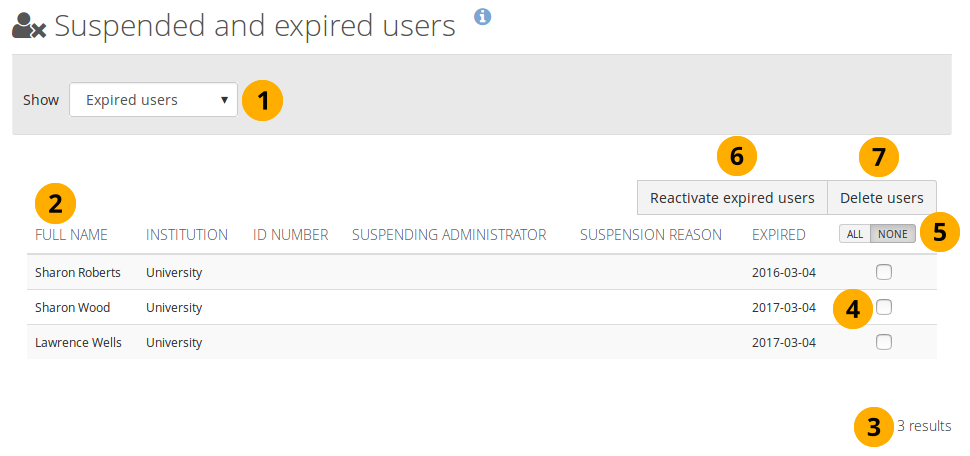
List of all expired accounts¶
Show: Select to view expired accounts.
Basic details about each account are displayed to ensure that you are looking at the correct ones. That includes the dates on which the accounts were expired.
The total number of expired accounts is shown.
Select the account(s) for which you want to perform the same action.
Click the All button if you want to select all expired accounts or click the None button to reset your selection.
Click the Reactivate expired accounts button if you want to allow these people access to their accounts again.
Click the Delete accounts button to delete all selected accounts in bulk. This action cannot be undone and all personal information will be deleted (see delete account).
Warnung
When you delete an account, all personal data is wiped from the system. This action cannot be undone. The person’s contributions in groups, e.g. forum messages, uploaded files and pages created in a group, are still available, but are made anonymous by changing the name to ‚Deleted account‘ as author where an author is shown.
11.4.4. Site-Mitarbeiter/innen¶
Administration menu → People → Site staff
Bemerkung
Sitemitarbeiter sind nur für Siteadministratoren sichtbar.
On this page you can choose which peoples receive site staff rights. Potential staff members - anybody on the site - are listed on the left while existing site staff members are listed on the right.

Site-Mitarbeitsrechte vergeben¶
Search: If you have too many people on your site and you cannot see the ones you want, you can search for them here.
Potential staff: Select the people you wish to make site staff. You can select multiple persons at once using
CtrlandShiftclick.Verschieben Sie die ausgewählten Nutzer auf die rechte Seite - derzeitige Mitarbeiter - durch Anklicken des Pfeil nach rechts-Buttons .
Current staff: If you want to remove an existing or accidentally added site staff member, you can remove them from the list on the right-hand side by clicking on their name.
Then click the left-arrow button , and the person is removed from the list.
Wenn Sie alle Mitarbeiter/innen ausgewählt haben, klicken Sie auf den Bestätigen-Button.
Bemerkung
Sie können einen Nutzer auch zweimalig anklicken, um ihn von einer Seite auf die andere zu schieben.
11.4.5. Site-Administrator/innen¶
Administration menu → People → Site administrators
Bemerkung
Siteadministratoren sind nur für andere Siteadministratoren sichtbar.
Site administrators have powerful permissions. They can make far-reaching changes and also log in as other person. Be careful whom you give these rights. One site administrator is needed for each site. The total number of site administrators should be kept small.
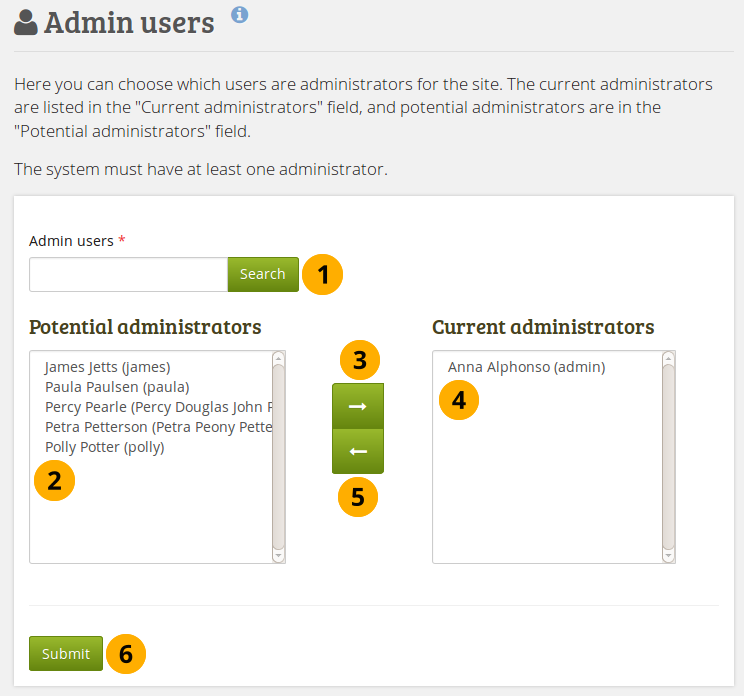
Give site administrator rights¶
Search: If you have too many people on your site and you cannot see the ones you want, you can search for them here.
Potential administrators: Select the persons you wish to make site administrators. You can select multiple persons at once using
CtrlandShiftclick.Add the potential site administrator to the right-hand side - Current administrators - by clicking the right-arrow button .
Current administrators: If you want to remove an existing or accidentally added site administrator, you can remove the person from the list on the right-hand side by clicking on their name.
Then click the left-arrow button , and the person is removed from the list.
Klicken Sie auf den Bestätigen-Button, um alle Änderungen abzuspeichern.
Bemerkung
Sie können einen Nutzer auch zweimalig anklicken, um ihn von einer Seite auf die andere zu schieben.
11.4.6. Export-Warteschlange¶
Administration menu → People → Export queue
Das Feature ist experimentell
Die Export-Wrateschlange ist für folgende Exportprozesse verfügbar:
Wenn ein Gruppen-Administrator oder Tutor Portfolios für Gruppen ermöglicht, wird die Archivierung eingereichter Ansicht ganz am Schluß der Exportprozesse ausgeführt.
If the site administrator enabled the feature to queue exports, exports that account holders initiate via Main menu → Manage → Export are also queued. Once completed, a notification is sent to download the export file within 24 hours.
 All available export formats are considered for the export since Mahara 20.04 and only one combined export made.
All available export formats are considered for the export since Mahara 20.04 and only one combined export made.
Siehe auch
The export queue requires that cron runs.
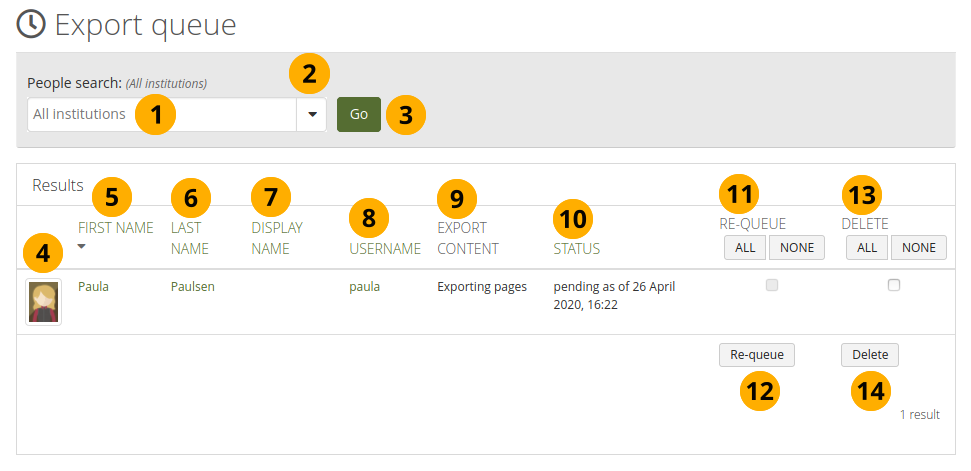
Export queue for exports¶
Search: Enter your search term. The default text in the field shows you in which institution context you perform your search. Type the name, display name or username or email address or any partial thereof you wish to search for in the search field. If you turned on the exact search, you need to provide the correct name or email address and not a partial one.
Use the drop-down arrow to choose a single institution in which to search for a person.
Klicken Sie auf den Starten-Button, um die Suche zu beginnen.
In the results table you see the profile picture of the person.
First name: Displays the first name of the person. This is the default column for sorting results.
Bemerkung
Die anderen Bezeichnungen im Kopf der Spalte sind Links und ermöglichen die Tabelle anders zu sortieren.
Last name: Displays the last name of the person.
Display name: Shows the display name of the person.
Username: Clicking on the username, you are taken to the person’s account settings page instead of their profile page as you would with the other names.
Exportinhalt: Kurzbeschreibung über durchgeführte Exporte.
Status*: Zeigt den Status der Exportabwicklung. Es werden ausstehende und gescheiterte Exporte angezeigt.
Export: Tick the checkboxes in this column if you wish to re-run an export that has failed. You can select all checkboxes by clicking the All button or remove all checkboxes by clicking the None button.
Click the Re-queue button to re-run all selected failed exports.
Delete: Tick the checkboxes in this column if you wish to delete any pending or failed exports. You can select all checkboxes by clicking the All button or remove all checkboxes by clicking the None button.
Click the Delete button to delete all selected pending or failed exports.
11.4.7. Add a person¶
Administration menu → People → Add a person
You can add people to your site (site administrator) or your institution (institution administrator) by creating accounts for them manually one by one.
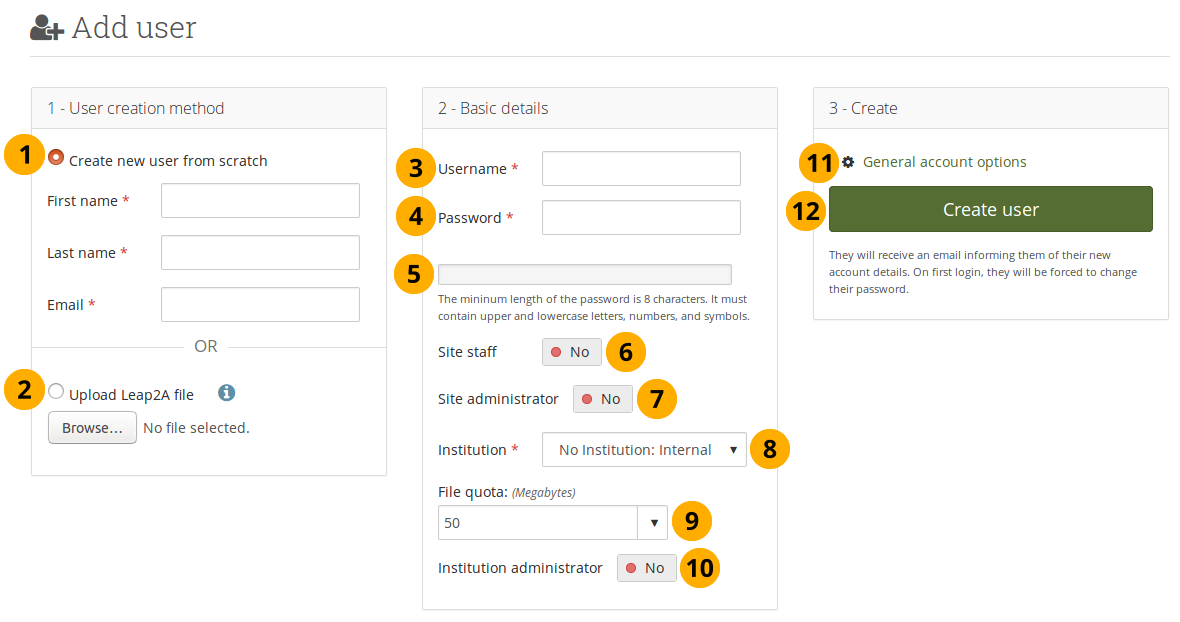
Add a person manually¶
Click the Create new account from scratch radio button if you want to create an empty account. Provide the first name, last name and email address for this person.
Click the Upload Leap2A file radio button if you want to import an account from another Mahara instance or a system that supports the Leap2A standard. Such a person could have exported their portfolio from another Mahara instance.
Username: Give the new account holder a username. It may contain letters, numbers and most common symbols. It must be from 3 to 236 characters in length. Spaces are not allowed.
Passwort: Wählen Sie ein Passwort für den Account. Das Passwort muss mindestens sechs Zeichen lang sein.
The password strength indicator gives you an idea of how strong your password is in relation to the password policy.
Site staff: Switch to ‚Yes‘ if the new account holder should have site staff rights. Only site administrators see this option.
Site administrator: Switch to ‚Yes‘ if the new account holder should have site administrator rights. Only site administrators see this option.
Institution: Choose the institution of which the person should be a member. You also select the authentication method directly here.
Bemerkung
If an authentication method requires the use of a remote username, you can enter that on the next screen in the account settings.
File quota: Review the allocated file quota. You may change it here for this person if you are allowed to.
Institution administrator: Switch to ‚Yes‘ if the new account holder should have institution administrator rights in the chosen institution.
General account options: Click this link to see default account options that you may choose to change while creating this account. These are the general account options a person can change on the Settings page.
Bemerkung
You can only define the default account settings for an account, but not force the person to keep them forever. You could only do that by customising the system on the code level.
Click the Create account button.
The person will receive an email with the account details.
11.4.8. Add and update people by CSV¶
Administration menu → People → Add people by CSV
You can use this function to upload new accounts in bulk via a CSV file (comma-separated file) and to update existing accounts. The first row of your CSV file should specify the format of your data. For example, it should look like this:
username,password,email,firstname,lastname,studentid
For new accounts, this row must include:
Benutzername
Passwort
E-Mail
Vorname
Nachname
Bemerkung
Mahara also accepts CSV files that have a semicolon as separator instead of a comma.
If you want to update existing accounts, you do not need to set a password and can leave that field off entirely.
Bemerkung
You can mix new and existing accounts in your CSV file. When you add a new account, the password field must be present. If you do not wish the password to be changed for existing accounts, leave that field empty for these accounts.
If your site or institution has locked fields or fields that are mandatory, then you do not have to include them as fields in your CSV upload.
Hier finden Sie die vollständige Liste zusätzlicher Felder, die beim CSV-Upload verwandt werden können.
address - Strasse
blogaddress - URL des eigenen Blogs
businessnumber - berufliche Telefonnummer
city - City
country - Land
expiry - Sets the date on which a person’s login is disabled automatically. This needs to be a valid date in the future, e.g.
2019-03-25
25 Mar 2019
+3 months
faxnumber - Faxnummer
homenumber- private Telefonnummer
industry - Branche (wird im Profil angezeigt)
introduction - die Einführung (Selbstbeschreibung) wird im Profil angezeigt
mobilenumber - Mobilrufnummer
occupation - Beruf (wird im Profil angezeigt)
officialwebsite - Offizielle Webseite
personalwebsite - Persönliche Webseite
preferredname - angezeigter Name
remoteuser - externer Nutzername für externe Authentifizierung
studentid - Die Nutzer-ID wird im Profil angezeigt.
town - Stadt
Hier ein Beispiel für eine CSV-Datei zum Nutzerupload:
username,email,firstname,lastname,studentid,preferredname,remoteuser, password"percy","percy@pearle.net","Percy","Pearle","","","percy.pearle","mahara1""petra","petra@petterson.net","Petra","Petterson","","","petra.petterson","mahara1""polly","polly@potter.net","Polly","Potter","","","polly.potter","mahara1""admin","admin@mahara.school","Admin","User","","","","mahara1""jamesj","james@jetts.com","James","Jetts","","","","mahara1"Nachdem Sie Ihre CSV-Datei erstellt haben, sind Sie bereit zum Upload.
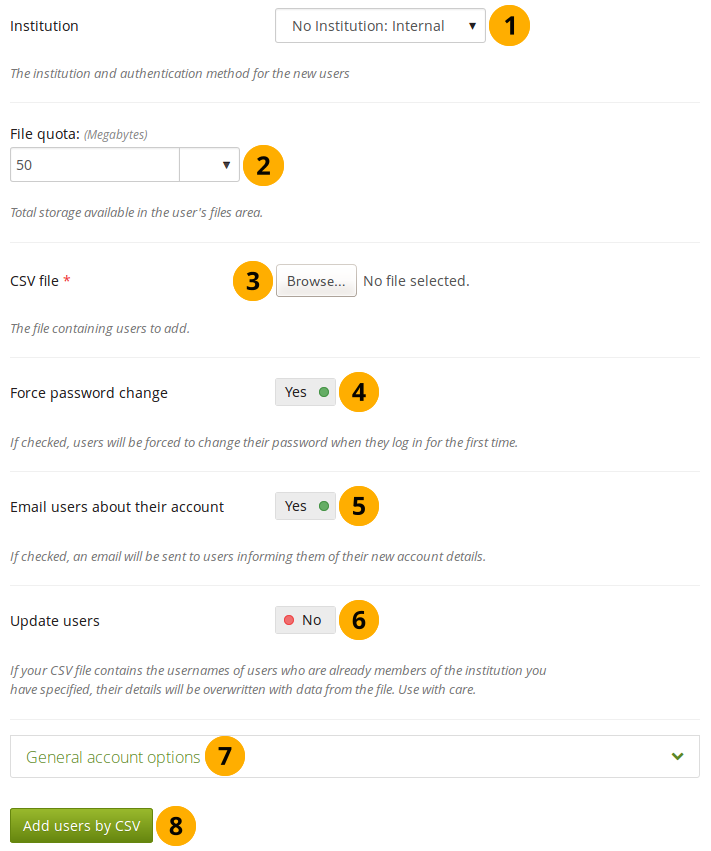
Add people by CSV file¶
Institution: Choose the institution and the authentication method for the accounts that you upload and / or change.
Dateikontingent: Wenn Sie wollen, kann ein angepasstes Dateikontingent für alle Accounts in der CSV-Datei festgelegt werden. Institutionsadministratoren können dies nur dann tun, wenn sie von der Site-Administration das Recht dazu erhalten haben.
CSV-Datei: Sie müssen die CSV-Datei über den Durchsuchen-Button auf Ihrem Rechner suchen und auswählen.
Force password change: If you select this option, people need to change their password before they can log in for the first time.
Email people about their account: Change the switch to ‚Yes‘ and people will receive an email with their account information. This is in particular good for internal accounts.
Bemerkung
For accounts that are managed by an external authentication method such as Moodle or LDAP, do not select this option because the account holders already know their login information.
Update accounts: Change the switch to ‚Yes‘ if your CSV file contains changes for existing accounts.
Bemerkung
When you add a new email address for a person to update the account settings, this new email address becomes the primary email address.
The previously used email address stays in the account as secondary email address until the account holder deletes it.
General account options: Expand this menu to see default account options that you may choose to change while creating or updating accounts. These are the general account options a person can change on the Settings page.
Click the Add people by CSV button to upload and / or change accounts.
Bemerkung
Depending on your server settings and / or the size of your installation, you may not be able to upload all accounts at once. You may wish to upload them in bunches of 100 instead.
A progress bar shows the percentage of the completed upload of your accounts.

11.4.9. Ändern Sie auf einmal die Authentifizierungsmethode und den entfernten Nutzernamen für mehrere Nutzer.¶
Nachdem Sie neue Mitglieder erfolgreich in ihrer Institution hinzugefügt oder eingeladen haben, können Sie deren Authentifizierungsmethode anpassen. Dies kann sinnvoll sein, wenn die Authentifizierungsmethode von der in einer früheren Institution abweicht oder die neuen Accounts mit einem entfernten Nutzernamen verknüpfen wlolen:
LDAP Directory
Moodle-Accounts via MNet
Single sign-on über einen IdP-Provider
Bemerkung
The change in the authentication method for existing accounts should be done before people try to log in with their new credentials to avoid the creation of a second account for them.
You can change the authentication method for multiple accounts at once to save you time manually updating each account. Changing the authentication method usually also entails changing the remote username (a.k.a. username for external authentication). Therefore, these two are dealt with together to describe the work flow better.
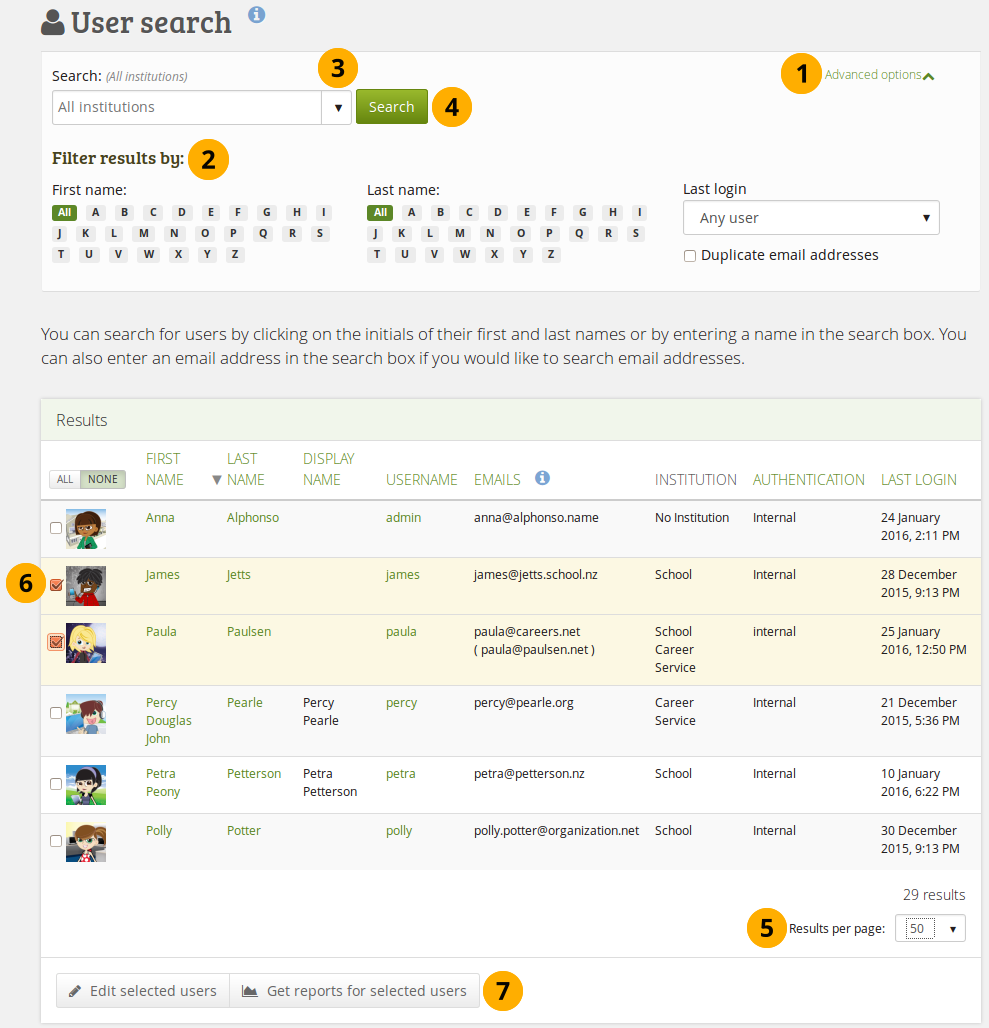
Find accounts in an institution to change their remote username¶
Go to Administration menu → People → People search.
Click the Advanced options link to show filter options.
Filter for accounts by specific characteristics, e.g. if you only wish to display peoples who have not logged in yet.
Search: Enter your search term. The default text in the field shows you in which institution context you perform your search. Type the name, display name, username or email address or any partial thereof you wish to search for in the search field. If you turned on the exact search, you need to provide the correct name or email address and not a partial one.
Use the drop-down arrow to choose a single institution in which to search for your person.
Click the Search button to start your search.
Change the Results per page if you wish to see more than 10 results per page.
Select the persons whose authentication method and remote username you want to change by either putting a check mark in the checkboxes or clicking on All to select all accounts on that page.
Click the Get reports button to proceed to the next step. You are taken to the Account details report page.
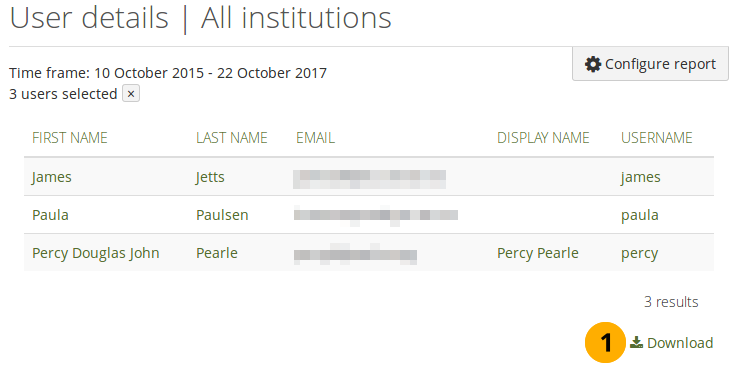
Account details reports page¶

Aktualisierung der CSV-Datei mit entfernten Nutzernamen und Passworten¶
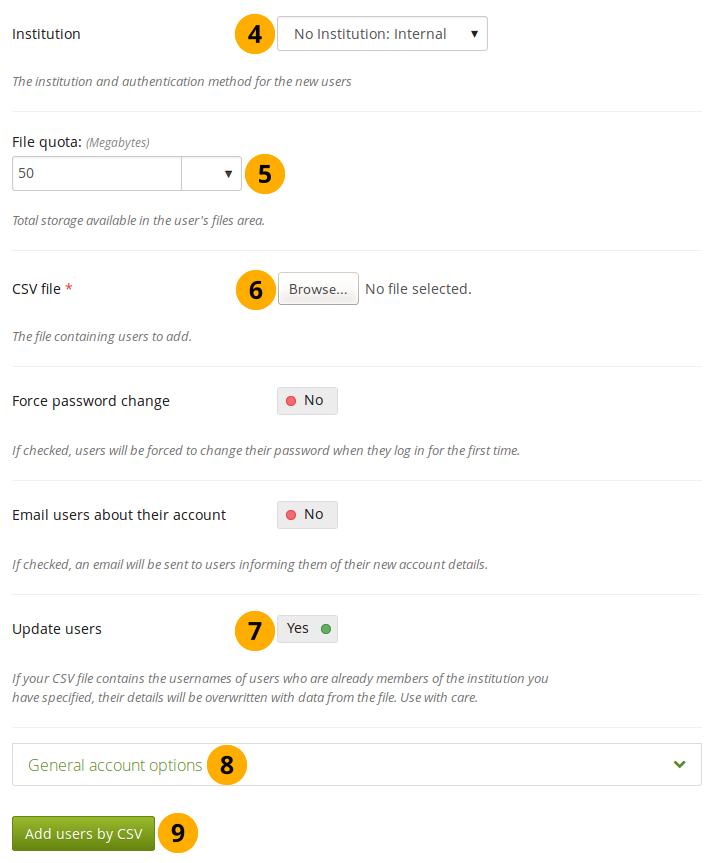
Update accounts in bulk¶
Click the Download button so that you get a CSV file which contains all necessary information for you to change the remote username in bulk. This is necessary if their internal Mahara username is not the same as the one they use to authenticate on your system that is linked to Mahara or if they already have a remote username that would be incorrect for your institution.
Bemerkung
You do not need to see the column ‚Remote username‘ for the data to be in the CSV download. If you wish to see it on screen, click the Configure report button and select the ‚Remote username‘ column.
Open the CSV file in your preferred spreadsheet software. In the column remoteuser, add or change the username that your account holders have when authenticating in your regular system that you have connected to Mahara. You may also change other fields, e.g. their name, email address etc. If you want to add a new person directly in this CSV file, you can do so as well.
Bemerkung
You must provide a password for a new account. All others do not need to have a value in the password field. If you only want to update existing accounts, you can leave the password field entirely off.
You must remove the column ‚lastlogin‘. Mahara will produce an error if you leave it in the file.
Go to Administration menu → People → Add people by CSV.
Institution: Choose the correct institution and authentication method for which you want to update accounts. This allows you to switch all accounts in the CSV file from one authentication method to another.
File quota: Choose a different file quota here if you want to update it for accounts you upload.
CSV-Datei: Wählen Sie die CSV-Datei auf Ihrem Computer, die Sie angepasst haben.
Update accounts: Switch this option to ‚Yes‘ because you want to update existing accounts.
Bemerkung
Switch the options Force password change and Email people about their account to ‚No‘. When you add a remote username, your account holders do not need to know their internal Mahara password as they cannot use it anyway.
General account options: You can make changes to the default account options for everyone, e.g. give them multiple journals by default, change their interface language etc.
Click the Add people by CSV button to start the update. This process may take a little while depending on how many accounts you are changing.
You receive a report on the page upon the successful completion of the upgrade. If the upgrade fails, error messages help you to resolve the problem. No accounts are updated until all errors are resolved.
Bemerkung
If you intend to update more than 100 accounts at the same time, you may run into problems, and the server may reject your CSV file as the update process is a very memory intense one. If that is the case, you would have to split your CSV file into smaller ones with fewer accounts in them.
Sie können prüfen, ob den Nutzeraccounts die externen Nutzernamen zugeordnet wurden:
Go to Administration menu → People → People search.
Wählen Sie die Institution mit den Mitgliedern, die Sie überprüfen wollen.
Click the Search button to limit your results to this institution.
Select the accounts for whom you want to check the remote usernames.
Click the Get reports button to proceed to the next step. You are taken to the Account reports page.
Sie sehen den externen Nutzernamen in der letzten Spalte.
Siehe auch
If you only want to change the authentication method of certain accounts but do not have to worry about a remote username or updating any other information, you can change the authentication method directly on the bulk actions screen.